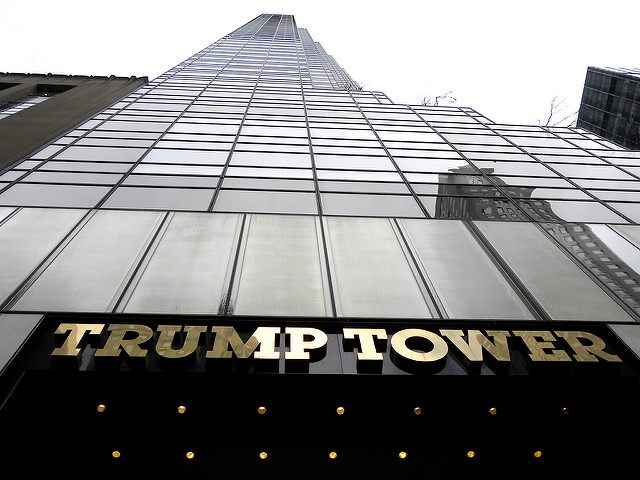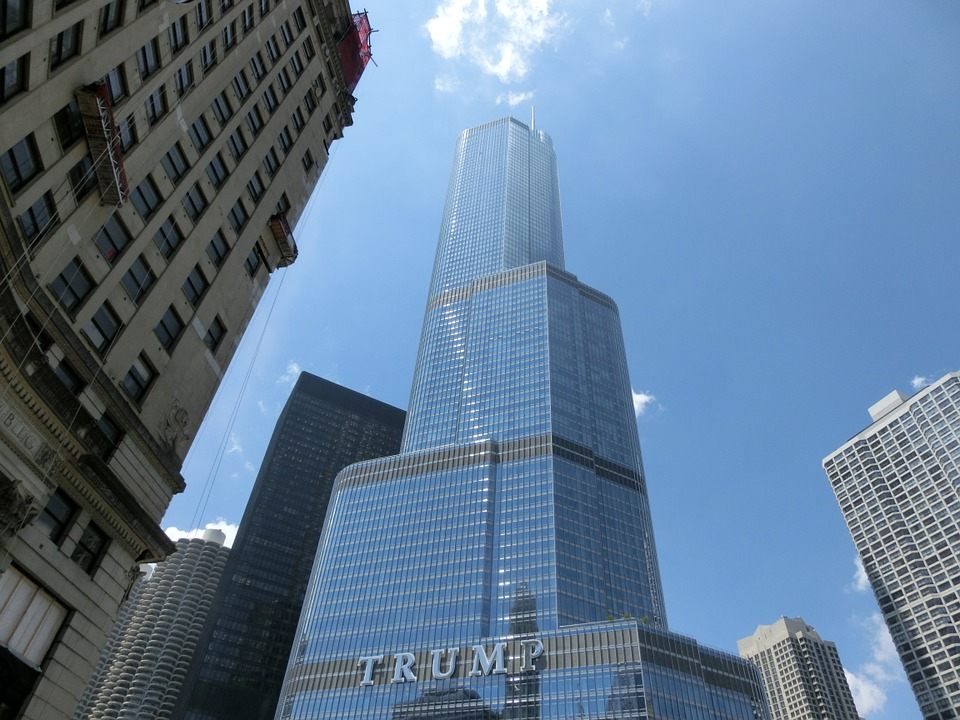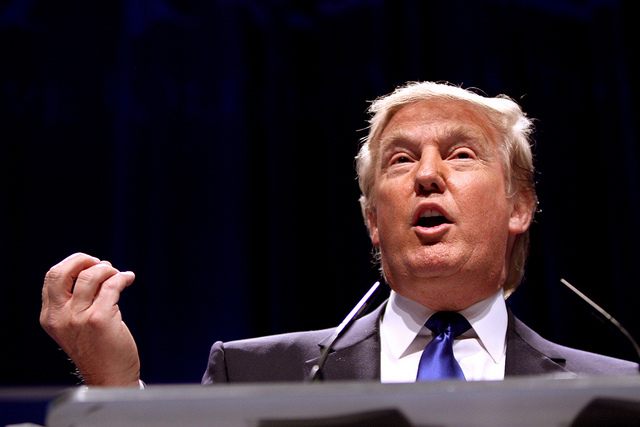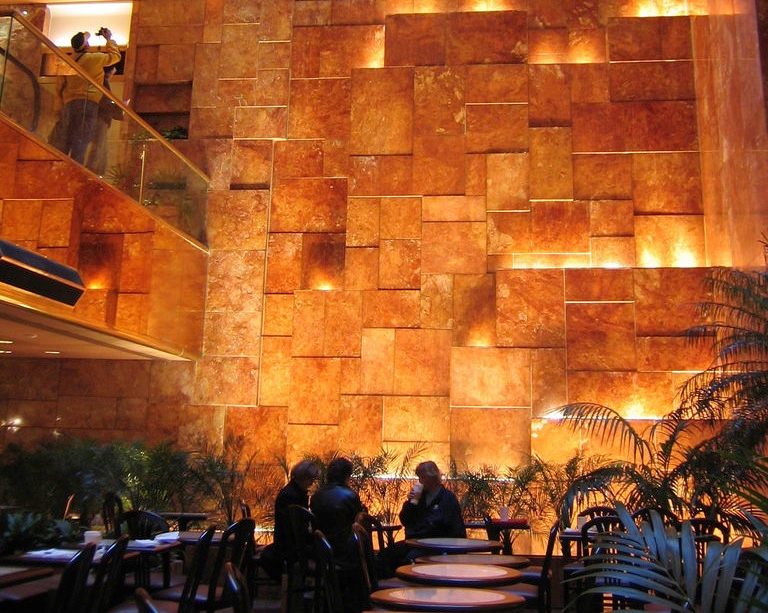Trump Tower Was Never Actually That Tacky
One critic called its atrium the “most pleasant interior public space” built in New York City in years.

The entrance to Trump Tower (Photo: Rev Stan/CC BY 2.0)
To enter the atrium of 725 Fifth Avenue, open to the public from 8 a.m. to 10 p.m., you must pass through the black gateway and underneath the two-foot-high letters, burnished in gold, that have spelled out, since the early ’80s, exactly whose building this is. This is Trump Tower. Here, you are entering the domain of Donald Trump.
The doorman is wearing a classic doorman hat, flat-topped and round-brimmed. He would look like any other doorman, except that underneath his coat, he is wearing a conspicuous black-and-white striped vest and around his neck, a bowtie. For Trump Tower, this is understated. Once, just after the building first raised the city skyline, there were doormen stationed here in full-on British cos-play—“a comic-opera version of English beefeaters,” as one critic wrote.
It was details like the guards’ uniforms that, not long after the building opened, inspired the first quiet uses of the epithet that’s often used to describe its brash developer. Donald Trump, people started saying, was tacky.
Three decades later, this label is stuck not just to Trump himself, but to the people and projects most closely associated with him. Celebrity Apprentice was “alluringly tacky.” Trump and his first wife Ivana were “two of the tackiest people in the history of America,” and the Trumps as a group were “New York’s tackiest family.” Trump’s buildings are “gaudy-bordering-on-repulsive.” This is not a partisan slur, either: The National Review has called Trump “tedious, tacky, and trite,” and both P.J. O’Rourke and The New York Times have crowned him “the king of bad taste.” Marco Rubio recently tried to employ it as an attack line (“those tacky ties”) in his spree of anti-Trump negativity.
When an insult is that automatic, though, it’s worth asking: what has the person done to deserve it? Is it actually true? What, exactly, makes Donald Trump and his towers tacky?

Trump International Hotel & Tower, Chicago (Photo: jensjunge/CC0)
“Tacky” is by its nature subjective. The word marks an object or person of poor taste or quality, and Trump has his own views on what’s tacky (a runner once used in Trump Tower, the old Trader Vic’s at the Plaza, promoting your hotel as the site of Chelsea Clinton’s wedding, the Oscars).
But tacky also implies that the nature of that bad taste is its bigness or showiness. Tacky is over the top. In the South, where the term “tacky” comes from, it had another gloss, too. A “tacky” originally referred to a horse—and not a very good one. At some point, established Southern families started to use it to refer to newly wealthy people whose families didn’t quite rate.
The first, tentative allusions to the tackiness of Trump began not long after Trump Tower opened, in 1983. The writer of a 1984 New York Times profile called Trump’s buildings “preposterously lavish” and “showy, even pretentious,” and he reported that some New York gentry (unnamed, of course) considered Trump “unrestrained by the bounds of good taste.” By the end of decade, the press had stopped dancing around it: in 1991 when another reporter asked Trump if a particular decision had been tacky, he replied, “I’ve been accused of tackiness before.” By the 2000s, everyone knew, without a question: “If there’s someone who knows what tacky is, it’s Donald Trump!”
Even his friends sometimes agreed that Trump’s design choices were over the top. “His taste is all right,” Philip Johnson, an architect with whom Trump has worked closely, told the Times in 1984. “But it is sometimes overwhelmed by his sense of publicity. He will become less and less glitzy. He’ll listen to me.”

The man himself, in 2011 (Photo: gageskidmore/CC BY-SA 2.0)
Trump’s sense of style hasn’t changed, though, and if tacky is equivalent to “over-the-top,” then plenty of Trump’s decorative choices qualify. They reveal the same instincts he’s shown in the political arena—be big, be aggressive, be willing to offend.
Trump and his current wife, Melania, live in the penthouse of Trump Tower, and a few years back, the fashion site Refinery29 published a series of photos of its interiors. Inside Trump’s private world, the rooms are filled with gilt and gold; they are Versailles-like in their abundant luxury. Chandeliers hang from the ceilings, and the front door is encrusted with gold and diamonds.
Arguably, Trump’s political and interior design choices even share some overtones of authoritarianism. The decor of the Trump penthouse fit, uncannily well, with a style that the British writer and cultural commentator Peter York has named “dictator decor.”
In his 2006 book, Dictator Style, which examined the interior design favored by authoritarian leaders from Joseph Stalin to Idi Amin and Saddam Hussein, York laid out 10 guidelines to “get the look.” On almost every point, says York (who, it must be noted, self-identifies as “both a British snob and a Bernie Sanders supporter”), Trump hits the mark.
The rooms of his penthouse, for example, are too big. That’s Rule Number 1: Big It Up. Rule #5 is Go for Gold—clearly covered. Rule #3: Think French. Check. Rule #10: Have yourself everywhere.
“His taste and his imperatives line up exactly with the rules of dictators’ homes,” says York. “These homes are not driven by the desire to be comfortable, to do family, to collect things you care about,” York says. “The drive is to impress and intimidate people.” Trump is telegraphing another message, too. “It’s a confidence trick. Everything he does is saying I’m very, very rich.”
Whether or not this is in good taste, there is a market for it: the dictator design style that York describes is often found not just in the homes of actual despots but in the houses of newly minted tycoons. In other words, potential Trump Organization customers.

This is actually just Versailles (Photo: Kallgan/CC BY-SA 3.0)
Most businesspeople in Trump’s position leave design decisions to professionals, but Trump has turned his personal brand into his professional calling card. Though the Trump Organization has hired some of the most respected designers in the world, Trump and his family have always had a hand in crafting the look of Trump buildings.
In the ‘80s, when Trump Tower went up, Ivana Trump was the Vice President of Interior Design at the Trump Organization: it was she who outfitted the British doormen (“They are fun,” she told the Times), and had the handrails of Trump Plaza repainted to Cadillac gold (“We had to go out and buy goddamned Cadillac paint,” the building’s construction manager said). After he bought the famous Mar-a-Lago property in Florida and turned it into a resort, Trump got tired of the decorator he’d hired and started redoing guest rooms himself, because, he told the Palm Beach Post, “I thought I could do better.” More recently, he boasted, about his Chicago Trump tower, “I had more to do with the design of that building than [architect] Adrian Smith did.”
Often, Trump’s interventions into his designers’ work and the imposition of his personal taste is what makes people think Trump’s properties are tacky. In Chicago, Trump enraged city leaders by spelling out TRUMP in two-story-tall letters on the side of his tower.
But, for the most part, the buildings in the Trump Organization’s portfolio have little tackiness about them. If you scroll through the pages of the 50-some hotels, towers, and golf courses connected to the company, they look more or less like any other luxury properties. The towers are tall, yes, but the interiors are generally done by fancy design firms in New York, or Europe, with seemingly little input from the Trump family. They have been well received by designers, architects and critics.
Sometimes the modulation of the Trump aesthetic is attributed to his daughter, Ivanka, who’s supposed to have more refined taste than her parents. But this dynamic—big, maybe even tacky gestures gilding actually-perfectly-tasteful buildings—has been around as long as Trump Tower. In a 1983 review of Trump Tower, architecture critic Paul Goldberger wrote that while it might have been expected that the building “would be silly, pretentious and not a little vulgar,” in reality “the atrium of Trump Tower may well be the most pleasant interior public space to be completed in New York in some years.”

The Trump Tower atrium (Photo: Alistair McMillan/CC BY-SA 2.0)
Today, the choices that drew those whispers of “tacky”—the British guards, the giant flower podiums shaped like double-Ts, Ivana herself—are no longer present at Trump Tower, but the atrium is still a pleasant public space. Inside the imposing entrance, the atrium glows rosy and yellow with marble, brass and mirrors, and a waterfall cascades down the back wall.
There is Trump-branded everything here: a Trump store, a Trump bar, an Ivanka Trump jewelry display. But the many mirrors also serve to reflect your own image back at you, and it’s as if Trump is signaling that all the marble and brass isn’t just about him, it’s also about you. Now that you’re inside, admit it: aren’t you enjoying yourself?
Long before Trump was using big, bold, controversial statements to get free political press and draw fans to his campaign, he used the same strategy to get people into his buildings.



















Follow us on Twitter to get the latest on the world's hidden wonders.
Like us on Facebook to get the latest on the world's hidden wonders.
Follow us on Twitter Like us on Facebook